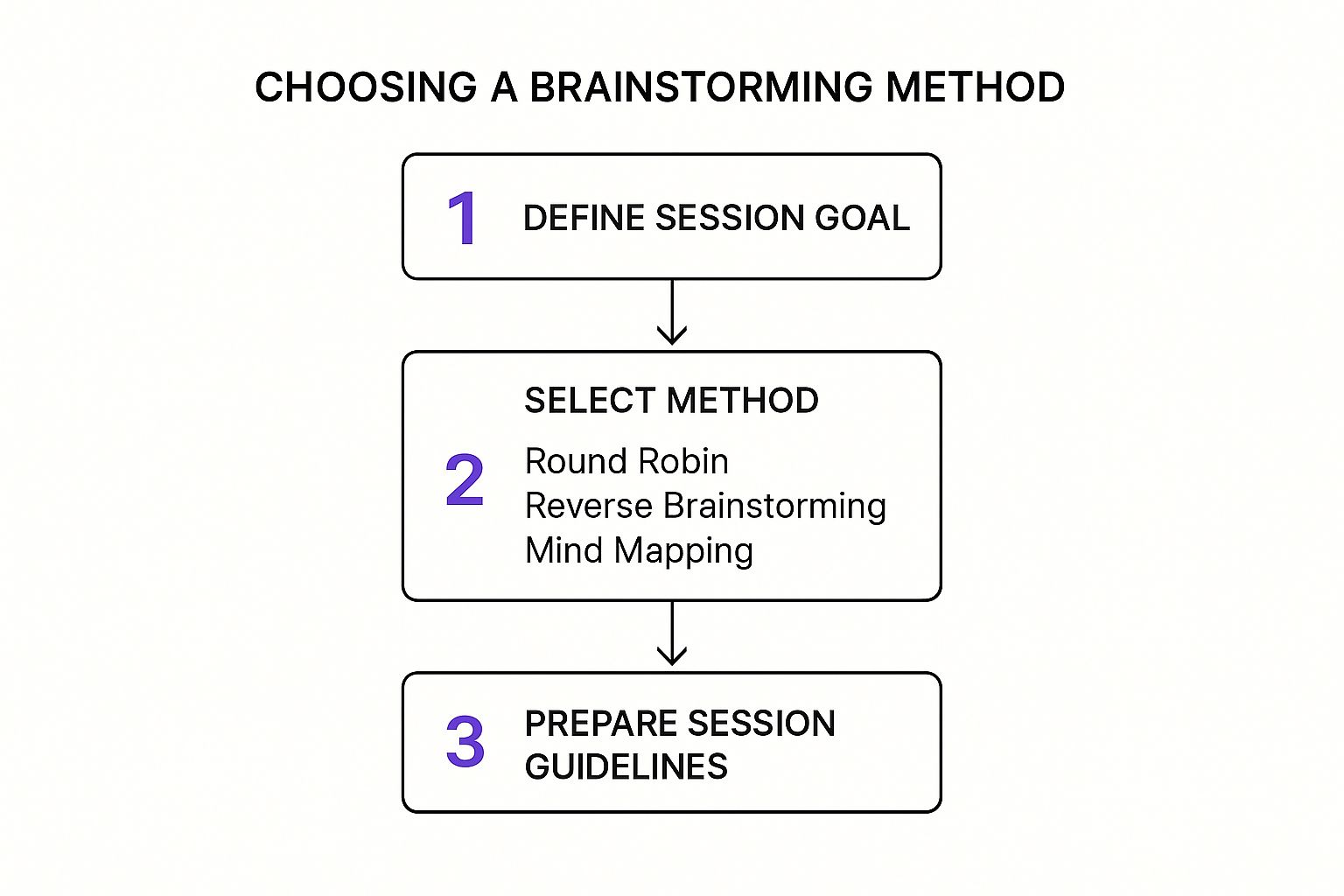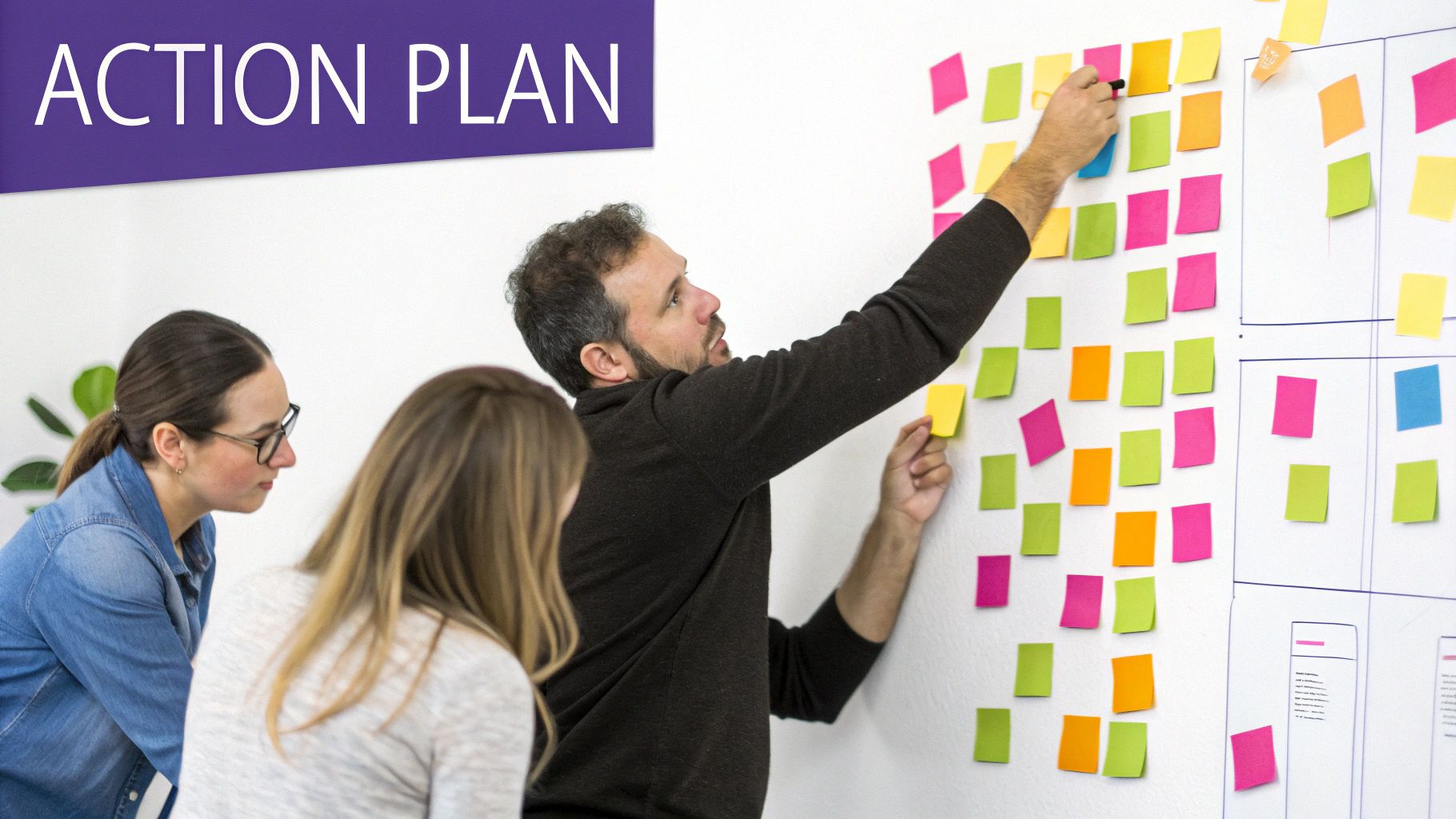To get the most out of a brainstorm, you need a clear goal and the right people in the room. From there, it’s all about using structured exercises to get a flood of ideas on the table before anyone starts critiquing them. The secret sauce is keeping idea generation separate from evaluation; that's where the creative magic happens.
Setting the Stage for a Breakthrough Brainstorm

The success of your brainstorming session is often determined long before anyone jots down an idea. Good preparation is what separates a frustrating, circular conversation from a meeting that sparks genuine breakthroughs. It’s all about creating an environment where creativity isn't just possible, but probable.
This isn't a new concept. The whole practice was developed back in the late 1930s by ad exec Alex Osborn, who needed a better way for his teams to come up with creative ad concepts together. It worked. His firm's early sessions churned out thousands of usable ideas, proving that a little structure goes a long way.
Define Your Central Problem
You can’t find the right answers if you’re asking the wrong questions. A vague goal like "improve our product" is a recipe for a rambling, unfocused mess of a meeting. You need to give your team a clear, sharp target to aim for.
Before you even think about generating ideas, get crystal clear on what you're trying to achieve. Using a framework like SMART goals is a fantastic way to make sure your brainstorming is tied to real, measurable results.
For instance, a weak problem statement is, "How can we increase sales?" A much stronger, more focused one is, "How might we reduce shopping cart abandonment for first-time customers by 15% in the next quarter?"
See the difference? This specific framing provides the guardrails your team needs to stay on track. Everyone in the room immediately knows:
- Who we're focused on (first-time customers).
- What the exact problem is (cart abandonment).
- What success looks like (a 15% reduction).
Assemble a Diverse Team
The best ideas often come from the collision of different viewpoints. Putting the right group together is more art than science, but your primary goal should be cognitive diversity, not just a collection of people from the same department. If everyone in the room thinks alike, you're not going to get very far.
A great mix might include:
- An engineer who can speak to technical feasibility.
- A customer support rep who hears user frustrations every day.
- A marketer who understands the competitive landscape.
- Even someone completely unrelated to the project for a truly fresh pair of eyes.
The real aim here is to build psychological safety—an environment where every single person feels comfortable sharing a weird, half-baked, or unconventional idea without fearing judgment. This is the absolute bedrock of creative teamwork.
When people feel safe enough to voice those "out there" ideas, you get the kind of risk-taking that leads to truly original solutions. Fostering an atmosphere of psychological safety at work is non-negotiable for a successful brainstorming session.
Choosing Your Brainstorming Method
Simply telling your team to "throw ideas out there" is a recipe for chaos. It’s like trying to build a house without a blueprint—you might end up with something, but it probably won’t be what you wanted. The right structured technique can completely transform a brainstorming session from a free-for-all into a productive workshop.
The key is matching the method to your goal. A team trying to name a new product needs a different approach than a team trying to fix a persistent software bug. One requires wild, expansive creativity, while the other demands focused, analytical problem-solving.
Find the Right Tool for the Job
Not all brainstorming techniques are interchangeable. Some are built for speed and generating a high volume of ideas, while others are designed to encourage deep thinking or make sure the quietest person in the room gets heard.
For example, do you have one or two people who tend to dominate every meeting? Try a Round Robin brainstorm. In this exercise, each person shares one idea in turn, going around the circle. It naturally levels the playing field, ensuring everyone contributes and preventing anyone from hijacking the conversation. It might feel a bit slower, but the diversity of ideas you get is well worth it.
This infographic breaks down the basic thinking behind picking an approach that fits your specific goal.

As you can see, aligning your method with your objective from the very beginning provides the structure you need to get things done.
To make this even clearer, here’s a quick-glance table to help you match some popular techniques to the right situation.
Matching Brainstorming Techniques to Your Goal
| Technique | Best For | Key Benefit |
|---|---|---|
| Round Robin | Encouraging participation from everyone, especially in groups with dominant speakers. | Guarantees equal airtime and diverse input. |
| Mind Mapping | Visually exploring a central topic and its related sub-ideas. | Great for organizing thoughts and seeing connections. |
| Reverse Brainstorming | Identifying potential problems, risks, or roadblocks in a project or plan. | Uncovers hidden weaknesses by focusing on failure. |
| Starbursting | Thoroughly exploring a new idea or topic before developing solutions. | Generates deep understanding by focusing on questions, not answers. |
Experimenting with different methods will quickly show you which ones resonate with your team and best fit the kind of challenges you face.
Thinking in Different Directions
Sometimes, the best way forward is to think backward. That’s the entire premise of Reverse Brainstorming. Instead of asking, "How do we succeed?" you ask, "How could we absolutely guarantee this project fails?" or "What could we do to make this problem even worse?"
This may feel strange at first, but it's an incredibly effective way to spot potential pitfalls before they happen. Once you have a solid list of ways to fail, the team works together to flip them into proactive solutions.
By intentionally focusing on the negative, you can uncover risks that a purely optimistic brainstorm would miss. It's a strategic way to pressure-test ideas before they ever leave the whiteboard.
Other methods help your team flex different mental muscles:
- Mind Mapping is perfect for visual thinkers. You start with a central concept and branch out, connecting related ideas. It’s a fantastic way to organize complex information and see the bigger picture.
- Starbursting flips the script entirely by focusing only on questions. Using a six-pointed star (who, what, where, when, why, how), your team generates as many questions as possible about a topic before even thinking about answers.
Picking a technique isn't just a box to check; it’s a strategic decision that sets the tone for the entire session. If you’re curious about other exercises, our guide on different brainstorming methods dives into more than a dozen options. The more tools you have in your kit, the better equipped you'll be to unlock your team's best ideas.
Guiding the Session for Maximum Idea Flow

A productive brainstorming session rarely happens by accident. It needs a guide. As the facilitator, think of yourself as part traffic cop, part cheerleader. Your job is to keep the energy up, the conversation focused, and the ideas flowing without any hint of judgment.
Simply put, you're there to protect the creative process.
This starts by laying down a few non-negotiable ground rules from the very beginning. These aren't just polite suggestions; they are the laws of the room that create a safe space for everyone to share their best—and sometimes wildest—thoughts.
The Unbreakable Rules of Brainstorming
The single most important rule is to defer all judgment. During the idea generation phase, no idea gets criticized, analyzed, or shot down. The goal here is quantity over quality. Aim for a hundred raw ideas, not five perfect ones. You'll be surprised how often a "bad" idea becomes the stepping stone to a brilliant one.
Another core principle is to encourage wild ideas. Thinking way outside the box is the whole point. Go for the absurd, the impossible, the truly out-there concepts. These stretch the group's imagination and often lead to unexpected breakthroughs. Also, get in the habit of building on what others share. Using phrases like "Yes, and…" expands on a thought, while "Yes, but…" shuts it down.
These rules work because they foster flexible thinking. A study actually found that students trained in this style of brainstorming—where they were encouraged to share even nonsensical ideas and avoid criticism—showed significant improvements in creative thinking skills. It's all about building mental agility. You can read the full research on developing flexible thinking here.
Managing the Room
Even with the best rules, you have to manage the human dynamics in the room. As a guide, you'll need to make small, real-time adjustments to keep things moving smoothly.
- Handling Dominant Voices: If one person is hogging the floor, you need to gently step in. A simple, "Thanks, Mark, great ideas. Let's hear from someone who hasn't spoken yet," works wonders. It validates their input while opening the door for others.
- Dealing with Lulls: Every session hits a wall eventually. When the energy dips, it's your cue to shake things up. Switch to a different brainstorming exercise, call a quick five-minute break, or just re-read the core problem statement aloud to refocus the group.
- Keeping the Focus: It's incredibly easy to wander off on a tangent. If the conversation drifts, gently bring it back. Try saying, "That's an interesting point. For now, let's bring our focus back to [the main problem]."
Your most important job is to be the guardian of the flow state. When the group is buzzing with ideas, protect that momentum at all costs. When it slows, your job is to be the spark that gets it going again.
Mastering these on-the-fly adjustments is a crucial facilitation skill. For a deeper dive into guiding group sessions, our guide on how to facilitate workshops offers more practical techniques. When you guide a brainstorm well, you ensure the team's collective brainpower is fully unlocked, leading to a much richer and more diverse pool of ideas.
Avoiding Common Brainstorming Roadblocks
Even the most well-planned brainstorming session can hit a wall. It’s not about having bad ideas; it’s usually about subtle group dynamics that quietly suck the creative energy out of the room. Knowing what these roadblocks are is the first step to dodging them.
One of the most common culprits I see is production blocking. It’s a simple, frustrating fact of life: only one person can talk at a time. While someone is sharing their idea, everyone else has to wait. In that pause, a brilliant thought can lose its punch or just fade away entirely before it ever gets said.
Then there's evaluation apprehension. This is just a fancy way of saying people are afraid of looking silly. We've all been there. Team members will subconsciously hold back their wilder, more "out there" ideas because they're worried about what their colleagues will think. This fear is a total creativity killer.
How to Tackle Groupthink and Fear
But perhaps the most dangerous trap is groupthink. This is what happens when the pressure to agree outweighs the courage to innovate. The first couple of ideas thrown out can anchor the entire conversation, and suddenly, every "new" idea is just a slight variation of the original. Originality dies on the vine.
To get around these issues, you need to change the rules of the game.
-
Try Silent Brainstorming (Brainwriting): Before anyone speaks, give everyone 5-10 minutes to quietly jot down their own ideas. They can use sticky notes or a digital tool. This simple trick completely sidesteps production blocking and lets everyone think without being influenced by the loudest person in the room.
-
Make it Anonymous: When people can submit ideas without their name attached, that fear of judgment melts away. Tools that allow for anonymous contributions are gold for this. People are far more willing to share a truly radical idea when they don't have to own it right away.
The real goal here is to separate the idea from the person. When you do that, the best concepts win on their own merit, not because of who came up with them or who talked the most.
Tools like Bulby are built for exactly this. They guide teams through exercises that encourage everyone to think for themselves first, before jumping into a group discussion. To see how powerful this can be, check out our guide on the benefits of anonymous brainstorming for some techniques you can use immediately.
Quick Fixes for a Stalled Session
Beyond setting up the right exercises, a good facilitator knows how to read the room and make adjustments on the fly. If you notice the conversation is just going in circles around one or two ideas, it’s time to hit the reset button.
A simple, effective tactic is to throw out a question that forces a totally new perspective. Let’s say you’re brainstorming a new app. You could ask, "What if our biggest competitor bought us tomorrow? What's the first thing they would change?" A prompt like that can jolt everyone out of a rut and unlock completely fresh thinking.
By planning for these common roadblocks, you can build a session that actively works against them from the start. You'll make sure every voice is heard and every great idea has a chance to shine.
From Creative Ideas to Concrete Action

The session's over. The whiteboard is a beautiful mess of sticky notes, and the room is buzzing with energy. So, what's next? This is the moment that separates a fun meeting from a truly productive one. Without a solid plan, even the most groundbreaking ideas will die on the whiteboard.
The first job is to tame the creative chaos. Start by grouping similar ideas. As you cluster the sticky notes, you'll naturally start to see themes pop up. For instance, an idea about "improving the login screen" and another about "simplifying the checkout process" could both live under a bigger theme like "Reducing User Friction."
This simple act of sorting turns a random collection of thoughts into a handful of clear strategic directions.
Prioritizing Your Best Ideas
Once you have your themes, you'll have a new problem: too many good ideas and not enough time. This is where you need to get ruthless with prioritization. You need a straightforward, objective way to decide where to invest your team's precious energy.
One of the best tools I've ever used for this is the Impact/Effort Matrix. Just draw a simple grid with four boxes:
- Quick Wins (High Impact, Low Effort): These are the absolute no-brainers. They deliver a big bang for your buck and should be at the top of your list.
- Major Projects (High Impact, High Effort): Think of these as your big, strategic bets. They can be game-changers but require serious planning and resources.
- Fill-Ins (Low Impact, Low Effort): These are the nice-to-haves. Tackle them when you have downtime, but don't let them distract from the bigger goals.
- Time Sinks (Low Impact, High Effort): Avoid these like the plague. They’ll drain your resources for very little return.
The goal here isn't to crush creativity—it's to channel it. Making the team weigh each idea by its impact and effort forces a realistic conversation about what’s actually achievable.
Building Your Action Plan
Okay, you've got your priorities straight. The final piece of the puzzle is turning those priorities into a concrete plan. Vague statements like "we'll look into it" are where momentum goes to die. Once a brainstorming session yields a wealth of ideas, the next crucial step is to distill them into actionable tasks. Tools like an action item extractor can help streamline this process, ensuring that promising concepts translate into concrete steps.
For every single idea you decide to move forward with, you must assign:
- A single owner: Who is the one person accountable for this?
- A clear next action: What is the very next physical step? Not the whole project, just the next step.
- A realistic deadline: By when will that next action be done?
This kind of disciplined follow-through is what separates teams that just talk about cool ideas from those that actually build them. You can dive deeper into this final, critical stage in our guide on moving from idea to implementation. When you leave the room with a clear action plan, you ensure the energy from your brainstorm converts directly into real, measurable progress.
Got Brainstorming Questions? We've Got Answers
Even the best-laid plans can leave you with a few lingering questions. When you're trying to nail down how to brainstorm the right way, it’s normal for some things to feel a bit fuzzy. Here are some of the most common questions we get from teams, with straightforward answers to help clear things up.
What’s the Magic Number for Group Size?
There’s no single perfect number, but experience shows that a group of 5 to 10 people really is the sweet spot. If you go with fewer than five, you often end up with a limited pool of perspectives. It can feel like you're all just echoing the same few thoughts.
But once you have more than ten people in the room, things can get messy fast. It’s tough to make sure everyone gets a voice, and you start running into "production blocking"—that frustrating moment when you forget a brilliant idea because you were waiting for someone else to finish talking.
If you’re working with a much larger group, the best move is to split them into smaller teams. Let them brainstorm in those intimate groups first, then have each team present their best ideas to everyone else later.
How Do I Get Quieter Folks to Speak Up?
This is one of the most important things to get right. Your quieter, more introverted team members often have incredible ideas but aren't always comfortable shouting over the more dominant personalities. The trick is to build in methods that don't rely on being the loudest person in the room.
Here are a couple of my favorite go-to strategies:
- Go Round Robin: This is as simple as it sounds. You literally go around the circle (or down the list of participants on a call) and give each person a turn to share one idea. No interruptions, no pressure to jump in—just a guaranteed spot to contribute.
- Give Brainwriting a Shot: This is a silent, written approach that works wonders. Hand out sticky notes or open a digital whiteboard and give everyone a few minutes to jot down their ideas on their own before anyone starts talking. It gives people the space to think without being influenced or interrupted.
Brainstorming vs. Brainwriting: What’s the Difference?
The core distinction is simple: brainstorming is a verbal, out-loud activity, while brainwriting is silent and written. Think of a classic brainstorming session—people are calling out ideas as they pop into their heads, building on each other's energy.
Brainwriting, on the other hand, starts with everyone writing down their ideas individually. Sometimes, those written ideas get passed around the group, letting others add thoughts or draw new inspiration from them.
Brainwriting is a powerful technique because it sidesteps some of the biggest brainstorming pitfalls. It completely gets rid of production blocking and dials down the influence of the most talkative people, which almost always results in a more diverse and creative pool of ideas.
What Do I Do With a "Bad" Idea?
Rule number one of any good brainstorming session is to park all judgment at the door. When someone shares an idea that seems a little wild, off-topic, or just plain "bad," your job as the facilitator is to simply say thanks and add it to the board. No commentary needed.
The moment you criticize an idea, even with a skeptical look, you can shut down the entire room's creative flow. You never know—that totally impractical suggestion might be the exact spark someone else needs to come up with a truly brilliant, workable solution. If the conversation starts to drift too far, you can always gently steer it back by reminding everyone of the main goal. Just never, ever call out a specific idea as a bad one while you're still in idea-generation mode.
Ready to see what your remote team can really do? Bulby uses guided, research-backed exercises to help you bust through creative blocks and land on those game-changing ideas. Start your free trial today and see how it works!

